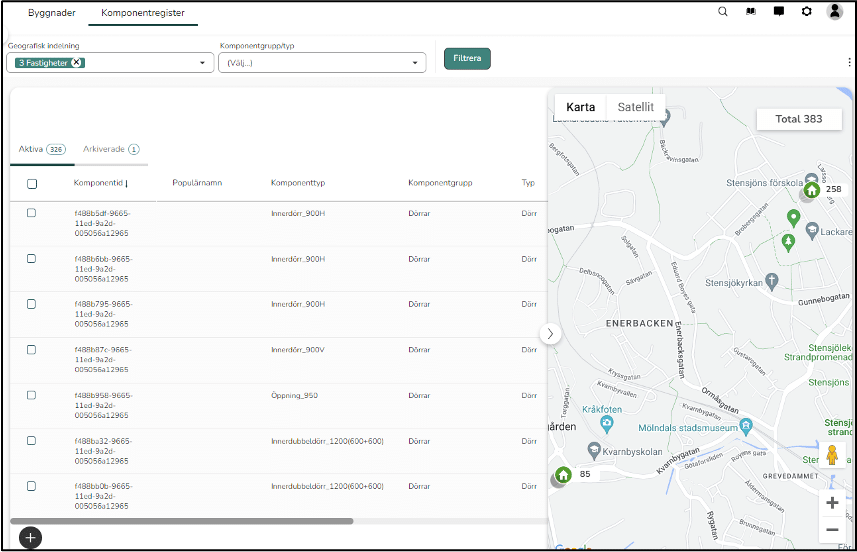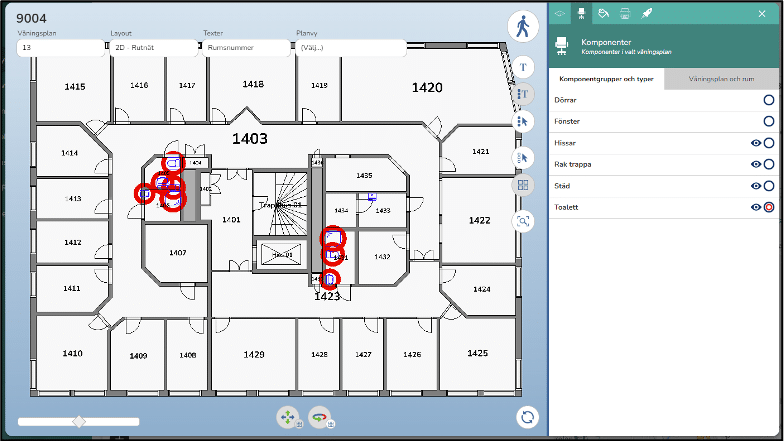Property management within the industrial sector imposes specific demands for structure, control, and flexibility.
How you structure the component register directly impacts how accessible and useful the information becomes in daily operations. With a clear hierarchical and dynamic structure, you gain both better control and more efficient workflows.
Component management is often highly complex, involving vast numbers of components of widely differing types, each with unique characteristics and requirements. A fire extinguisher, for example, has completely different attributes from a door, an electrical installation or a water pump. This means each component group must be identified and categorised flexibly to ensure effective management.
In an industrial property, this may involve thousands of components, each with its own specifications and attributes — many of which are critical due to their connection to production processes. This places high demands on the property system and the component register, from how you register attributes and data fields to managing large-scale updates and changes.
The component register – a core building block in the property system
In the Pythagoras property system, the component register is one of the core elements. Its dynamic structure and the digital twin of your property make the system unique. Whether you’re a property manager, facility operator or technician, you can easily navigate, plan, act and follow up on the status and actions of every component in your building.
But how does it work in practice? And what are the actual benefits for a property manager?
Three key benefits of the Pythagoras property system
Here are three commonly highlighted benefits that Pythagoras clients often mention – all of which simplify and streamline component management:
1. 1. Flexible categorisation of components with custom attributes
In Pythagoras, you can flexibly define which attributes should be linked to each component. This means you can, for instance:
- Adjust the level of detail as needed.
- Create specific field templates for different component types.
- Define which data should be shared across component categories.
The structure is based on each component always belonging to a component group and a component type. These categorisation concepts are used throughout the system to make it easy to search for and select the right components. When you change information in one place, it’s updated across all components with the same categorisation – reducing manual work and improving data quality.
Pythagoras provides a base register with commonly used property-related component types that can be activated if desired. Alternatively, you can easily create your own component groups and component types using the available field templates, with the option to create any number of custom templates.

Often, there’s a need to manage many components at once. The Pythagoras component register includes features for moving components between objects and copying components – along with their attributes – from one object to another.
2. 2. Efficient administration with dynamic import templates
The ready-made import functions and templates in the Pythagoras component register make it possible to:
- Import large amounts of data smoothly.
- Organise information into different sheets based on component type.
- Customise import files to get precisely the data you need.
The ease of adapting and modifying fields on an ongoing basis is something users particularly appreciate. It streamlines work and minimises deficiencies in component management. The dynamic import templates are based on how component groups, component types, and field templates are configured in the system and are created in Excel format.
A general recommendation when importing large numbers of components with varying data/attributes is to handle it as a separate project, supported by your system provider.
3. 3. Your property as a digital twin with exact component positioning

The visual interface with digital drawings and models makes the Pythagoras property system unique, fully integrated across all modules. It’s easily accessible via the web interface and the Pythagoras app. The digital twin becomes a practical tool in component management by:
- Allowing each component to be placed in the model and precisely located in a specific room.
- Increasing availability and usability of component data via a visual interface.
- Making maintenance work easier for operations and maintenance staff, thereby improving quality.
In the Pythagoras map view, both buildings and land areas are displayed. Clicking on a specific building reveals the floor plan, including all components on that floor. In the same way, you can locate components situated outdoors on the property.
On the floor plan card, you can also move, copy or delete components within the digital twin to reflect any changes made to the property.

Take the next digital step – start simple and scale up
Many organisations still lack a digital tool and rely on manual, time-consuming management and follow-up, often using Excel. This makes component management feel unnecessarily complex and inefficient.
When setting up a component register in your property system, the recommendation is to start simple. Base it on the needs and conditions of your specific organisation and properties. Then gradually expand with more details and attributes.
Want to learn more about how your organisation can optimise property management with a visual and dynamic component register? Book a demo and discover what Pythagoras can offer. .


